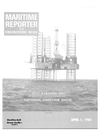
Page 49: of Maritime Reporter Magazine (April 1984)
Read this page in Pdf, Flash or Html5 edition of April 1984 Maritime Reporter Magazine
gram feature allows for ease of combat system reconfiguration into different types of architectures.
Consequently, SCSS can be used to study and analyze different combat system architectures.
Friday, May 4
Palladian Room—Session 3A
Combat Systems II
Moderator:
Radm. Wayne E. Meyer, USN
Como. (Select) Lowell J. Hol- loway, USN, assistant 9:30 a.m. "The New Jersey-Tomahawk
Story: From Retirement to Renais- sance—A New Strike Capability," by Gerald R. Bell.
This paper examines the adap- tation of the Tomahawk System for installation in New Jersey (BB- 62). The design modifications have been particularly critical, as the
Baseline System is currently un- der development in USS Merill (DE-392). Urgent Navy require- ments dictated the Battleship-
Tomahawk effort overtake and lead the Baseline development in Mer- rill. Emphasis in this paper is placed upon discussion of plan- ning, implementation, problems encountered, and the advanced ca- pabilities surrounding New Jersey as a result of installing the Toma- hawk weapons system.
The paper concludes with a dis- cussion of the potential opera- tional utilization of New Jersey in the strike warfare role that was lost to the surface Navy in World
War II, when aircraft carriers sup- planted battleships as the Navy's main strike arm. 10:15 a.m. "Detection—A Modern View," by Robert T. Hill.
Over the past 10 years or so, the
Navy in its surface combatants has introduced a modest amount of sensor integration and automa- tion, improving in several ways the "detection" function of the "de- tection-control-engagement" trio of functions embraced by the combat systems. After a review of the basic ideas of this integration, the further increases in inferential power that can be provided by ap- plication of several emerging tech- nologies to a fairly broad sensor base, including that of the force, are presented. The technologies include multi-sensor operations and netting, far more use of a priori information, more inference from present signal processing, new sig- nal processing, and the new com- puter circuitry, architecture, and programming fields frequently dis- cussed today. The paper concludes with a discussion of a possible way to proceed to improve systems, considering that we cannot "stop and start over" in much of our sen- sor system design in the major combatants. 11:00 a.m. "Rationale for an ADA Software
Engineering Environment for Navy
Mission Critical Applications," by
Robert A. Converse and LCdr.
Kathleen Paige, USN.
This paper describes the lessons learned about computer program development over the past 25 years, and discusses a software engineer- ing process that addresses these lessons. It then describes how ADA and its related ADA Programming
Support and Run-Time Environ- ments foster this software engi- neering process to improve com- puter program productivity and achieve greater system reliability and adaptability. Finally, the pa- per discusses how the use of ADA and its environments can enhance the interoperability and transfer- ability of computer programs among Navy projects, and signifi- cantly reduce overall life cycle (continued from page 56)
MARINE
MAGNETOMETERS
Shallow Marine Model SM 123
Deep Marine Model DM 123
SYSTEM FEATURES • 1 gamma accuracy and sensitivity • worldwide range capability • wide selection of cycle rates and chart speeds • nondirectional noise cancelling, toroid sensor • simple installation and operation • low overall system cost
SM-123
APPLICATIONS INCLUDE • marine salvage detection • pipeline and cable location • geophysical and hydrographic surveys • oceanographic and archeological research
UNITS AVAILABLE FOR SALE OR RENTAL
RB,\ RRINI ;I:R RESEA RCH *
I CANADA: 304 Carlingview Dr., Rexdale, Ontario, M9W 5G2
Tel: (416) 675-3870 Telex: 06-989183
U.S.A.: 1626 Cole Blvd., Golden, Colorado 80401
Tel: (303) 232-8811 Telex: 45810
Circle 160 on Reader Service Card
PHOENIX' SUPER=SEARCHLITE
FIXTURES 3
Models -Up to 2 Mile'
Range
Modular inter- changeable controls • give choice of lever, twist- lever, or wheel with 4 standard control lengths. Easily changed underway.
Marine aluminum drums with sealed,
tempered glass lens. No rack and pinion
gears for vertical movement. 500 or
1000 watt incandescent or quartz lamps.
PRODUCTS COMPANY, INC.
4785 N. 27th Street, Milwaukee, Wl 53209
(414) 445-4100 TELEX 910-262-3389 (PHOENXPROD MIL)
Circle 161 on Reader Service Card
'WE PROVIDE UPS
NOT LIP SERVICE!
There is a difference — Lips
Propellers' repair staff inspects and
reconditions propulsion sys-
tems ranging from complex
Controllable Pitch Propellers and
Transverse Thrusters to the largest
Monobloc Propellers. Our personnel
can straighten distorted blades,
excavate and weld cracks, repair
damaged edges and surfaces, re-
build cavitation eroded areas and
replace missing or bent tips. And our
engineering/design division can recom-
mend pitch, camber or diameter modifi
cation to solve your performance problems.
When "turn around time" is a priority,
call us. We routinely accomplish major
repairs in our three facilities meeting
critical drydock schedules. Lips Mobile
Emergency Service Team goes directly
to your chosen yard anytime, anywhere
to perform on-site repairs or "super-polish
service" within 24-hour notice.
Repair procedures meet the most exacting
requirements of ABS, Det Norske Veritas,
Lloyd's Register, NAVSEA and other
pertinent world class standards.
Whenever and wherever trouble strikes,
call us. We provide Lips Service.
!LIPS
Headquarters,
East Coast Operations
3617 Koppens Way, Chesapeake, VA 23323
(804) 485-5275
""-•""•""""----"--"----I
Please send full product information to:
NAME TITLE
COMPANY
ADDRESS
CITY STATE/ZIP
West Coast Operations
1899Seventh St., Oakland, CA 94607, (415)451-8219
Building64. P.O. Box 17161. OR97217, (503)289-9830
Swan Island Shipyard,
\9-9t
March 15, 1984 Circle 132 on Reader Service Card 51

 48
48

 50
50
